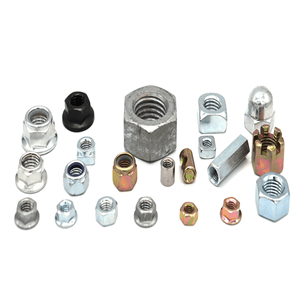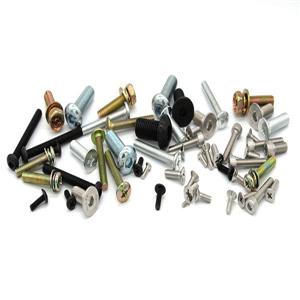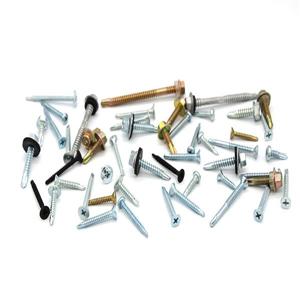Hydrogen embrittlement of alloy steel bolts (5)
5.5 Use corrosion-resistant materials to make bolts
The biggest advantage of using corrosion-resistant materials to make bolts is that there is no need for plating, which completely avoids the threat of hydrogen embrittlement. On aerospace vehicles of European and American countries, a large number of materials that do not require electroplating are used to manufacture bolts. These materials include:
● Iron-based alloy A286 (GH2132) with a strength level of 1100MPa;
● Nickel-based alloy wasploy (GH738) with a strength level of 1250MPa;
● Inconnel 718 (GH4169), a nickel-based alloy with a strength level of 1550MPa;
● Nickel-cobalt alloy MP35N (GH159) with a strength level of 1800MPa;
● Ultra-high-strength precipitation hardening stainless steel.
At present, domestic conditions have met the conditions for using corrosion-resistant materials to manufacture high-strength bolts. Commonly used materials for manufacturing bolts with a tensile strength of about 1100 MPa are superalloy GH2132 and titanium alloy TB3, TC4 and so on.
High temperature alloy GH2132 (foreign counterpart A286) is an iron-based superalloy with excellent corrosion resistance, high temperature performance and ultra-low temperature performance. It has high yield strength, endurance strength and creep strength at a high temperature of 650°C. After heat treatment, the tensile strength (under normal temperature) is above 920MPa, and the elongation (δ5) is not less than 15%. The Institute of Aeronautical Materials has also formulated the special specification Q/6S 1032-1992 "YZGH2132 Alloy Rods for High-Temperature Fasteners", which has a tensile strength of up to 1100MPa. At present, this material has been widely used in the aerospace industry to manufacture bolts and self-locking nuts, not only at room temperature, but also at high temperature (650°C) and ultra-low temperature (-196°C).
The corrosion resistance of titanium alloys TB3 and TC4 is very good, and the strength after solid solution and aging can reach 1100 MPa. Since electroplating is not required, delayed hydrogen embrittlement fracture generally does not occur, but if the hydrogen content is too high, it will cause embrittlement of the material. At present, titanium alloy as a bolt material has been widely used in the aerospace field.
Nickel-based high-temperature alloy GH738 (corresponding to foreign brands wasploy) has high corrosion resistance, high yield strength and fatigue performance, without the need for electroplating. The working temperature is above 730℃. After heat treatment, the tensile strength at room temperature is above 1250MPa. The materials conforming to Q/6S 1035-1992 "GH738 Alloy Bars for High Temperature Fastening Parts" have been used to manufacture high temperature self-locking nuts for aerospace models.
The high-temperature nickel-based alloy GH4169 (corresponding to Inconel 718 abroad) has good comprehensive performance under high and low temperature conditions, the yield strength below 650℃ ranks first among all kinds of superalloys, and has good fatigue resistance, radiation resistance and oxidation resistance , Corrosion resistance, and good processing performance, are commonly used materials for aerospace vehicle structures, as well as commonly used materials for the manufacture of fasteners. After the alloy undergoes normal hot upsetting and solid-solution aging treatment, the tensile strength can reach more than 1280MPa, and the elongation (δ5) can reach more than 15%. If the appropriate cold deformation process is added, the tensile strength of the material can be increased to more than 1550MPa, and the elongation (δ5) is more than 8%. The surface of the part is generally ready for use after passivation treatment, without electroplating. The use of GH4169 alloy to make bolts can not only completely avoid the hydrogen embrittlement problem of the bolts, but also solve the adaptability of the bolts to high and low temperature environments. For this purpose, the Institute of Aeronautical Materials issued the corporate standard Q/ 6S 1034-1992 "GH4169 Alloy Bars for High Temperature Fastening Parts".
Precipitation hardening stainless steel is a type of high-strength stainless steel that can be strengthened by heat treatment. After proper heat treatment (including cryogenic treatment), the tensile strength of this type of material can reach more than 1400 MPa, or even more than 1600 MPa, and it also has quite good toughness. American 17-7PH, 17-5Mo, etc. belong to this type of material. 0Cr12Mn5Ni4Mo3Al is a low-nickel alloy independently developed by my country from the 1960s to the 1970s, commonly known as “69111”. The alloy is a semi-austenitic precipitation hardening stainless steel with controlled phase transformation. Its corrosion resistance is between austenitic stainless steel and martensitic stainless steel. After heat treatment, the tensile strength can reach more than 1600MPa, and the elongation (δ5 ) Reach over 14%, and the area shrinkage (ψ) can reach over 50%. Preliminary tests show that stainless steel 69111 not only has high tensile strength, but also has good plasticity, toughness and fatigue properties. It may become an ideal material for manufacturing ultra-high-strength bolts. It has been approved as the aerospace industry bolt standard.
The hydrogen embrittlement fracture of metal materials is a complex process of physical and chemical changes. There are still many problems that require people to continue to explore and study. However, as long as we understand the basic mechanisms and laws of bolt hydrogen embrittlement fracture and take the necessary precautions carefully, we can definitely prevent the bolt hydrogen embrittlement fracture and eliminate the hidden quality hazards of mechanical equipment.




